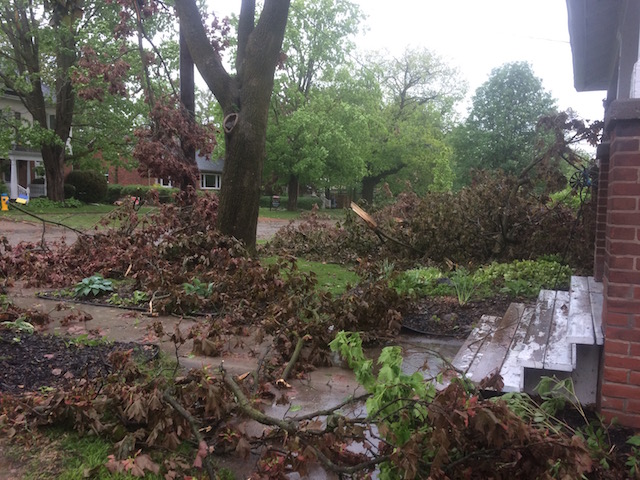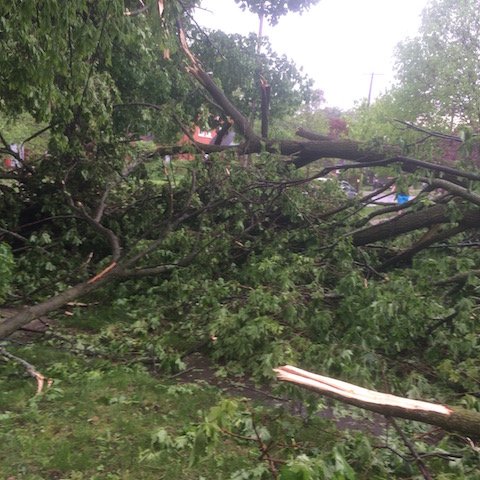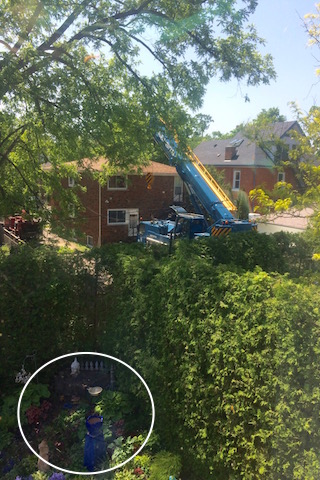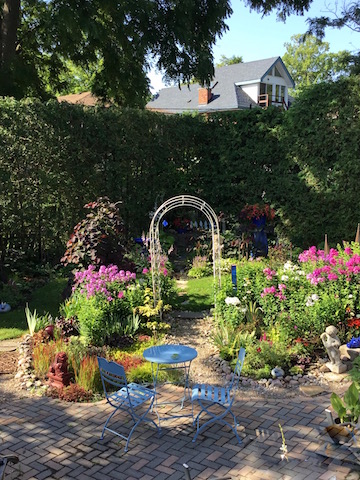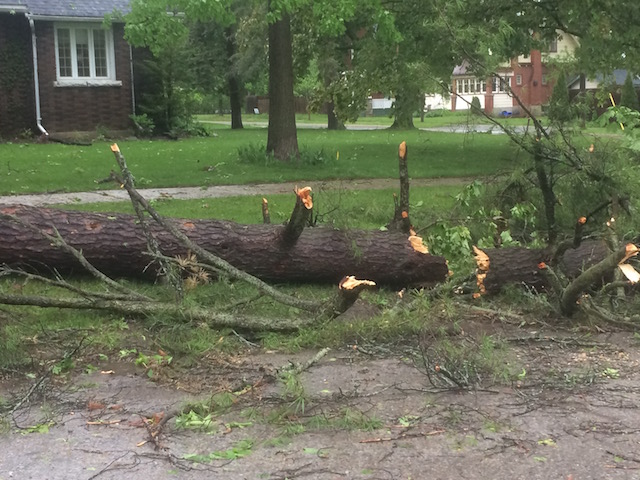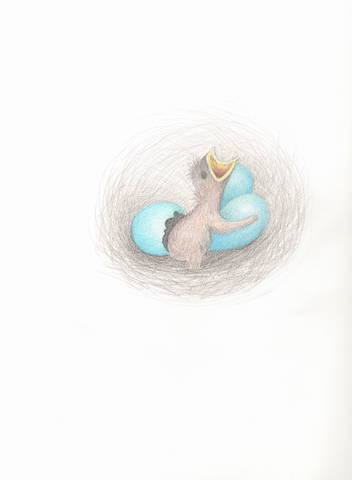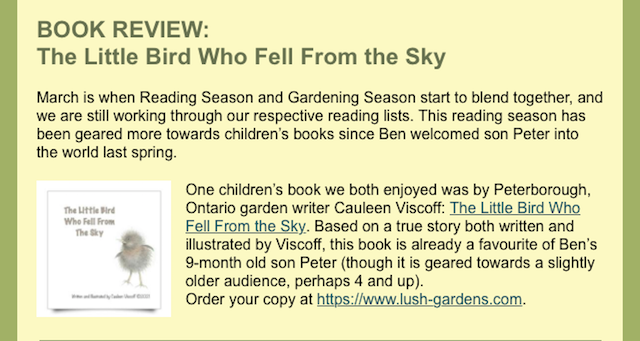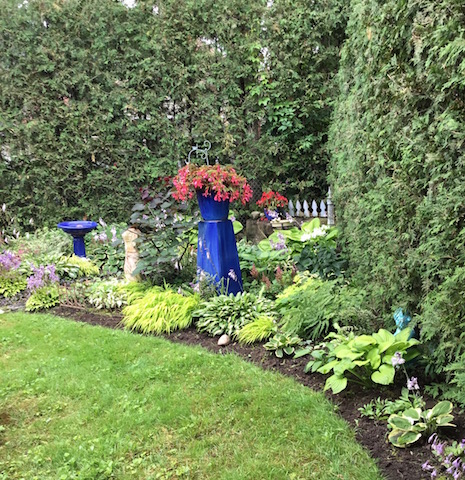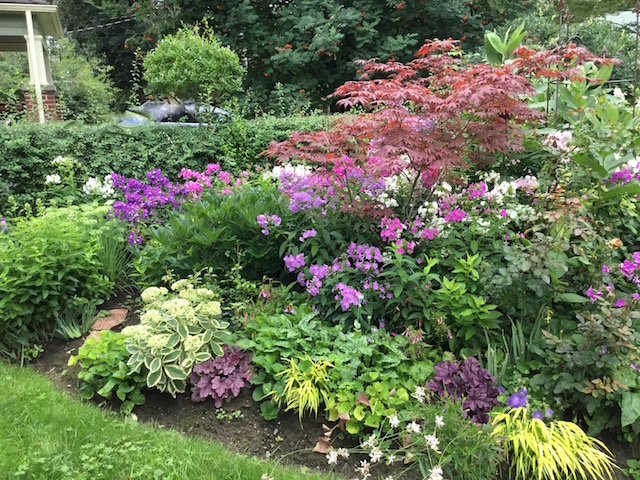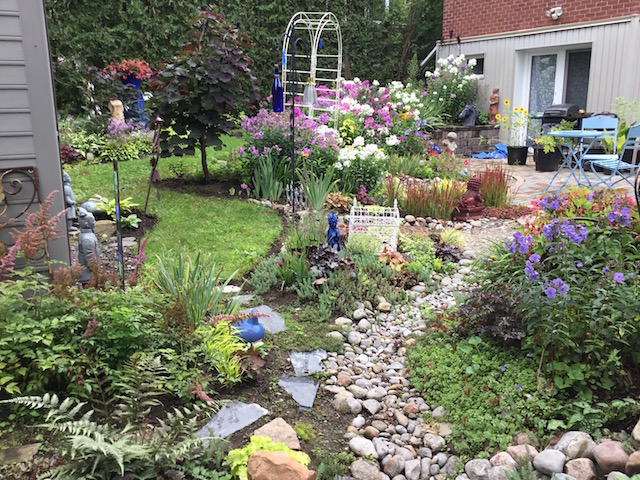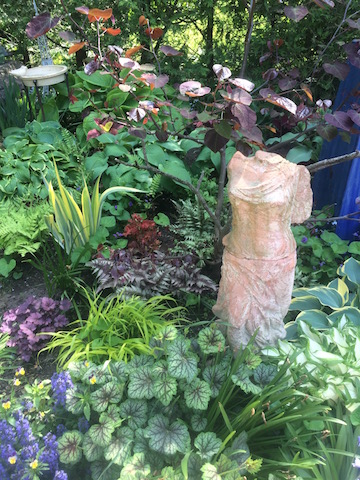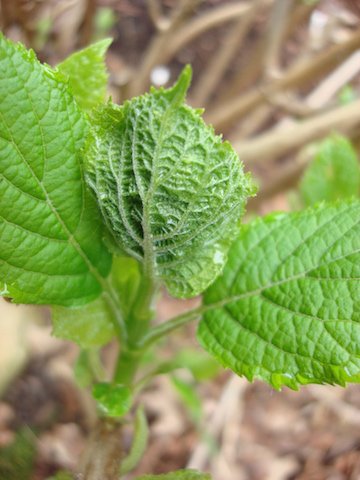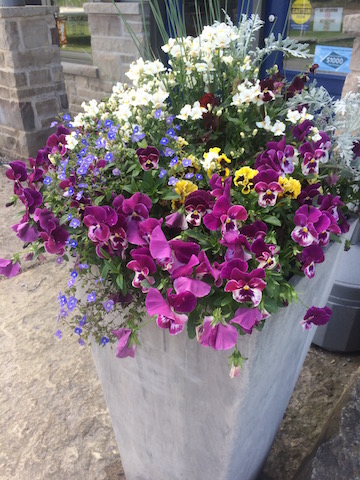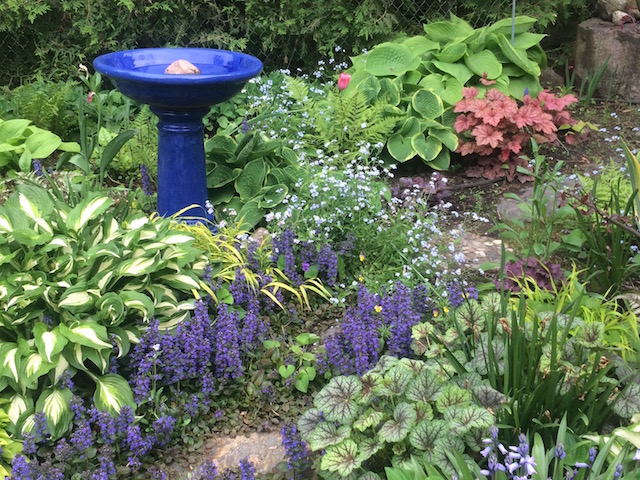| Back to Back Issues Page |
 |
|
Garden Bliss & Blunder, Issue #012 June 09, 2022 |
It's June !
As I write this...
...about bliss and blunders, I am feeling grateful and a bit philosophical because it’s near the end of May, 2022 and in southern Ontario, we are still cleaning up after a whirl wind “Derecho” (a fancy name for a line of intense, widespread, and fast-moving windstorms and sometimes thunderstorms that moves across a great distance and is characterized by damaging winds) Our neighbours were quick to help: we sawed, chopped, cut and carried branches from the street and sidewalks, clearing storm drains, doorways and cars covered in branches and tree trunks. Thankfully there were few injuries and mercifully no major damage to homes here although 10 storm related deaths in the area.
Ironically, most of the downed trees are Norway Maples (Acer platanoides) planted on many city streets as fast growing shade trees with the potential to live up to 80 years; alas, most are on boulevards and live 30 to 40 years.
Our city had declared a state of emergency and almost 900 workers from the US and Canada came with boom trucks to cut trees, repair hydro and internet lines… and over a week later, the chain saws are still whining…. the hospital is seeing many injuries from unaccustomed folks using chain saws, axes and muscles. Without power for a few days, we pulled out barbecues, lit gas stoves to make tea and coffee for neighbours and friends without…. (lukewarm tap water with instant coffee just didn’t cut it) - and grinding coffee beans resorted to hammering them - we are spoiled with our technology, televisions and phones… a few days of (tech) silence (except for chain saws, sirens and generators) is challenging…. no internet or emails…. some texting depending on the phone and nearest cell tower makes letting loved ones know we are okay.
Here is the enormous crane to lift fallen trees from behind homes and the circle is how far below is our garden. It is a story below street level and the crane is taller than the 3-story home behind us. Without power, we pulled out barbecues, lit gas stoves for tea and coffee for neighbours and friends (lukewarm tap water with instant coffee just didn’t cut it) - and grinding coffee beans meant hammering them - so spoiled with our technology, televisions and phones A few days of (tech) silence (except for chain saws, sirens and generators) is challenging…. no internet or emails…. some texting depending on the nearest cell tower to let loved ones know we are okay. We cooked potatoes and pasta for salads…. put bags of ice into coolers for yogourt and milk and pulled various bar-b-que-able meats from freezers… We found cards for Cribbage and read books hiding under sofa cushions- lots of walks, getting caught up with neighbours…. no news, no tv, no phones Cars from other neighbourhoods came to take photos and ask if we are okay… generosity and kindness abound… line ups at coffee drive-through with 150 cars… and grocery stores open until their generators fail…. How unprepared we are for this…. stuck in our cocoons of safe and isolated lives… Be prepared: they say… have water, batteries, candles, food that does not have to be cooked or cooled… sounds good… are we? mostly with the help of our friends. Having hot water for dishes and a blessed nighttime bath are luxuries we take for granted. We were lucky to have power on our street in a few days but many others are still without…. And yet, today, the first of June, many homes are still without power.
But it's JUNE !The hydro crews are still here, exhausted and still working to help us through this … but our garden lives go on; the weeds thrive and our plants are eager to show us it is June:
“I wonder what it would be like to live in a world where it was always June.” Lucy Maud Montgomery (1874-1942)
Canadian author of Anne of Green Gables The birds are still singing, bees still buzzing and getting on with what they do best… There is a powerful beauty in flowers as we plant in our gardens. It is time to sit in soft quiet moments thinking of the miracles in our immediate midst. These moments are blessings we can never afford to take advantage of. And although not all of us have an outdoor garden, plants will thrive happily indoors. The storm almost missed our garden and we came out relatively unscathed except for bits of branches that flew on the fierce wind, catching themselves on rose thorns and other unsuspecting plants. Our back garden is almost a story below the street level… surrounded by cedar hedges, and so untouched by those violent winds and pounding rain … lucky.
Co-incidence? maybe…
I just finished book called “the Virago Book of Women Gardeners” about women throughout history who gardened and wrote about it…. In 1919, The Viscountess Wolseley wrote: “All gardens, therefore, should have some hedged-in, completely sheltered part. It should be so shaped that shadow can be had at every moment in the days, while sunshine and protection from wind can both also be gained when wanted upon cold stormy days.”
How did she know our garden so well?
I am so sad, though......for the broken and tortured trees, but especially the big old pine tree that graced the end of the street .. lying torn and twisted, gaping nakedly in a tangled mess.
I am also sorry for the little birds and their wee nests - perhaps full of little eggs and tiny lives
… now haunted by the parents looking for new places to make home.
This sketch is from my book about a baby robin who fell from his nest and his adventures. The review below is by Mark Cullen Ben Cullen is his son. You can have a signed copy by going to my home page:
Garden Messes...… no matter what mess they may be in, we can always do a little bit. I met a lady whose garden is wild with grass and branches and twigs (no storm damage here, but time instead repairing health damage before getting back to the garden). It is daunting when weeds get the better of us… but here’s a trick I use when I don’t have time to do a full weeding: Start by edging the bed… Nice sharp edges that divide lawn from garden… Starting there, work toward the centre of the garden… ...a few minutes a day can make a big difference by the end of the week. Start with what you see first… either from your favourite spot - inside or out - or the first thing you see when you walk or drive up to your home.
And, if you plant your beauties close together there will be no room for weeds.
,,, Or use stones.... pea gravel and river rock work too. "Weeder Woman"...Weeding can be so satisfying … in the 17th century, those who could not afford gardeners spent their lives growing a few beans, but mostly weeding their gardens and were called “weeder women”… I like to think I am a gardener and not just a weeder.. but i confess there are days. Wouldn’t it be wonderful to be known as someone who has the knowledge of a professional and the eye of an artist… who is also opinionated but humble while sharing with other gardeners a happiness and satisfaction after a day of digging and making plans for future gardens. If that is what a ‘weeder woman” becomes with all that weeding … then I want to be that. And after we finish weeding, we’ll have room for more plants, right?
More Plants?
Just a few words of caution. - buy them in as big pot as you can afford. - if you leave them in plastic pots, remember they get really hot and need a lot of water - no matter where you buy plants in pots, pull them out of the pot when you get home and search the soil for the possibility of a new threat… Jumping Worms… I covered this in May's newsletter but worth a reminder...
Jumping Worms...So far they have been sighted in Dundas,East York,Toronto and the Blythwood Ravine:A jumping worm is like a nightcrawler on steroids, “instead of inching along like garden worms, they snap their bodies like angry rattlesnakes.” Unlike other types of earthworms, the pheretimoid jumping worm live in the topmost layer of soils consuming ALL fallen organic matter, including seeds, turning leaves into a material that resembles coffee grounds. In the absence of worms, a healthy forest develops a thick blanket of duff (leaf litter) that slowly decomposes over time. “That layer creates a home for insects, amphibians, birds, and native flowers. But when worms show up, they devour the litter within the space of a few years. All the nutrients that have been stored up over time are released in one giant burst, too quickly for most plants to capture. And without cover, the invertebrate population in the soil collapses,” WHAT TO DO: Inspect all plants and soil for these earthworms, eggs or cocoons. Remove any you find - yucky I know but wear gloves and pop them into a jar of vinegar -lid on tight… If you find jumping worms contact your local Canadian Food Inspection Agency office (CFIA) Tel: 647-790-1100.
Erogenous or Erroneous Zones?Enough bad news…. let's buy plants…. Reading plant tags can be rather confusing - especially about zones. Most plant tags are printed in the US and therefore indicate the USDA planting zones. The United States Dept. of Agriculture (USDA) and the Canadian hardiness map (NRC - National Resources Canada) should not be used interchangeably… ... they are different.
Canadian criteria uses 9 zones (0 to 8) with colder and warmer areas (a and b) and based on: minimum winter temps length of frost-free days maximum wind-speeds
The USDA is based on the average annual minimum temperatures with 11 zones ...and 8 of those are divided into colder and warmer (a and b). Easy way? If a plant is listed as USDA zone 5, consider choosing a plant hardy to Canada’s zone 4.
This may not be the most accurate way but might be the safest if a plant is at all tender.
Green is a Colour...
No matter what colour you love in your garden, remember that green is also a colour… There are yellow-greens, blue-greens, green-and-white, green and yellow etc…dark green and lime green … they set off reds, pinks, burgundy and purple … it is the contrast that makes a difference. Hydrangea-Leaf Tiers...
Have you seen this on your Annabelle Hydrangea? Little caterpillars (Tortricid Moth- not hugely a problem) apply silk along the edges of two new Hydrangea leaves, cementing or tying the leaves together, creating a little envelope. The caterpillars feed on the small flower buds inside.
Gently pull open the tied leaves to reveal a silk littered capsule with dark green frass (insect poop) and little caterpillars - light green, semi-transparent with shiny black heads and a black thoracic shield on top of the segment just behind its head… ... oh, too much information? If you wish, pull the leaves apart and squish the caterpillars… If you cut off the capsule, you will also cut off the flowerhead…. - depends on whether you want to squish them to save the blooms. There is more about other pests here:
Keep Pots Beautiful...
Plants in pots have different needs than those in the ground. Pots (plastic or otherwise) get hot and dry out quickly. You may find you have to water t hem daily… and once a week, put them into a tub of water and that soak up from the bottom…. those roots rarely get enough water from overhead watering. Deadheading will tell the plant to produce more blooms. Check for wee nasty bugs and if you find them, give them a squirt with a bit of dish soap in water Some plants will benefit from a haircut after blooming and send out more soon after. Fertilize…. use a 15-30-15 (NPK) weekly… unlike the plants in your garden that get nutrients from the soil, pots are heavy feeders and cannot get what they need from potting soil. If you have a heat wave, put them out of the sun for a day or two and let them revive… ... if you go away, either place them in buckets of water, or a deep tray filled with water to keep them until you return ..… unless you have a garden-friend you trust to water them.
Birds need Water too...They need water and so do bees.
A bird bath with fresh water daily is a boon for our wee thirsty birds. ... a flat dish with small pebbles and a bit of water will help thirsty bees..
Remember to hydrate - you and your plants a layer of mulch will help keep them moist and from dying out.. Enjoy the cool mornings, help each other, be kind and love your garden…. whether a tiny corner, a balcony, a nearby park or your own little patch…
One day at a time, one flower, one weed. Bye for Now...
Until next time…. when it is too hot to be in the garden, Lucy likes to be comfy inside watching her favourite movie: “Hotel for Dogs”
Back Issues for Garden Bliss & Blunder |
| Back to Back Issues Page |
